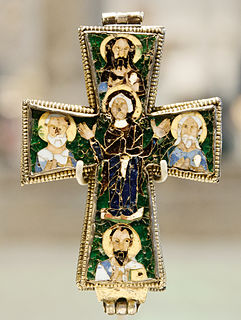 W
WThe Reliquary Cross is a late 10th century Anglo Saxon ivory figure of Christ, set on an Ottonian cross to make a reliquary in the form of a crucifix. It is now in the Victoria and Albert Museum in London.
 W
WThe Beresford Hope Cross is a 9th-century Byzantine reliquary cross with cloisonné enameling. It was intended to be worn as a pectoral crucifix, perhaps holding a fragment of the True Cross in the compartment inside. The cross is thought to have been made in southern Italy around the end of Byzantine iconoclasm, between 843 and the mid tenth century. It has been held by the Victoria and Albert Museum since 1886.
 W
WThe Brussels Cross or Drahmal Cross is an Anglo-Saxon cross-reliquary of the early 11th century, now in the treasury of the St. Michael and St. Gudula Cathedral, Brussels, that bears engraved images and an inscription in Old English.
 W
WThe Coronation Cross of Bohemia or the Gold Reliquary Cross is the most precious object of the Treasury of the St Vitus Cathedral in Prague. It is usually exhibited together with the Bohemian Coronation Jewels and is sometimes considered to be part of them. It is a gold reliquary in shape of a cross, which was created to contain the most valuable relics of the Kingdom of Bohemia. The cross was made by order of Charles IV, probably around 1354. The Reliquary Cross was not originally part of the St Vitus Treasury, but belonged to the Treasury of Karlštejn Castle. Since 1645 it has been permanently in Prague and became part of the St. Vitus Treasury. The cross was used during the coronations of Bohemian kings in St Vitus Cathedral, although it was not originally made for this purpose.
 W
WThe Cross of Adelheid is an 11th and 12th century reliquary in the form of a crux gemmata. It is held in Saint Paul's Abbey, Lavanttal. It was commissioned by Adelheid, daughter of Rudolf of Rheinfelden, passing to St. Blaise Abbey in the 19th century before coming to its present home. It is made of a wooden core covered with gilded silver plate. On the front are gems, pearls and precious stones. It is 82.9 cm high, 65.4 cm wide and 7.4 to 7.8 cm deep.
 W
WThe term Cross of Bernward principally refers to two Ottonian crosses in the cathedral museum in Hildesheim:
 W
WThe Cross of Cong is an early 12th-century Irish Christian ornamented cusped processional cross, which was, as an inscription says, made for Tairrdelbach Ua Conchobair, King of Connacht and High King of Ireland to donate to the Cathedral church of the period that was located at Tuam, County Galway, Ireland. The cross was subsequently moved to Cong Abbey at Cong, County Mayo, from which it takes its name. It was designed to be placed on top of a staff and is also a reliquary, designed to hold a purported piece of the True Cross. This gave it additional importance as an object of reverence and was undoubtedly the reason for the object's elaborate beauty.
 W
WThe Cross of Justin II is a processional cross dating from the sixth century that is kept in the Treasury in St. Peter's Basilica, in Vatican City. It is also one of the oldest surviving claimed reliquaries of the True Cross, if not the oldest. It is a crux gemmata or jewelled cross, silver-gilt and adorned with jewels in gold settings, given to the people of Rome by the Roman Emperor Justin II, who reigned from 565 to 578, and his co-ruler and wife, the Empress Sophia.
 W
WThe Cross of the Angels is a pre-romanesque Asturian reliquary donated by Alfonso II of Asturias in the year 808 to the Church of San Salvador in Oviedo, Asturias (Spain). The Cross of the Angels is the symbol of the city of Oviedo
 W
WThe crucifix of Ferdinand and Sancha is an ivory carving from circa 1063, today in the National Archaeological Museum of Spain. It was part of an offering by King Ferdinand I of León and Queen Sancha to furnish the basilica of San Isidoro de León. It is the earliest known crucifix from Spain depicting the body of Christ. Although earlier Spanish crucifixes of gold, ivory and wood are known, they are all without images. The official inventory of the royal gift describes the crucifix as "a cross of ivory with the image of our crucified Redeemer". It measures 52 cm high, 34.5 cm wide, and 1 cm thick, with the width of the cross beams being 7 cm. The image of Christ is 305 mm tall.
 W
WThe Cross of Neith was a sacred relic believed to be a fragment of the True Cross which had been kept at Aberconwy by the kings and princes of Gwynedd, members of the Aberffraw dynasty who established the Principality of Wales. They believed it afforded them and their people divine protection. It is not known when it first arrived in Gwynedd or how they had inherited it, but it is possible that it was brought back from Rome by king Hywel Dda following his pilgrimage in about 928. According to tradition it was handed down from prince to prince until the time of Llywelyn ap Gruffudd and his brother Dafydd. A representation of the cross came to be used as a Battle Flag.
 W
WThe Premyslid Crucifix from Jihlava. The Premyslid Crucifix is a polychromed wooden cross dating from the first half of the 14th century. It is on display at the Picture Gallery of Strahov Monastery in Prague. In 2010 it was declared a National Cultural Monument by the Czech government.